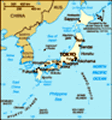Advertisement
Published: September 30th 2017
Geo: 35.4973, 138.755
Japan can be a funny place - while there are some aspects of life and culture here that are beautiful in their simplicity, there are others that are overly complex. More often than not, things that appear simple at first, end up being overly complex. It's a uniquely Japanese quality, so for the purposes of this discussion, we'll call it Japanese Simplexity! A good example was today's exhausting journey from Takaragawa to Fujikawaguchiko - while the Tokyo Wide Pass covered today's train rides, it involved four separate legs with multiple train companies. There are areas not entirely covered by the pass, involving supplemental costs, so it wasn't readily obvious if our journey was completely included, and online resources weren't all that helpful. It was only clear once we reserved through a station office, with the assistance of the attendant.
Even boarding the train in Japan can be confusing, as the Japanese have a system of painting information and lines on the ground, so that you can line up to board in the most efficient manner possible, without impeding disembarking passengers. It takes a few moments to decipher, but once you do, it all but eliminates the possibility of boarding the
wrong train. You'll know exactly where to stand to board car 5 on the train bound for Tokyo, and the door will line up just next to you when the train rolls in. And, from the files of
Only in Japan ... even the lineup has a line! On trains without assigned seating, the first line boards, then the second, then the third ... until it's full, and the guy who just missed out becomes first in line for the next departure. Brilliant!
An even better example was a late lunch at Sanrokuen, a restaurant serving up Irori, a unique type of Japanese BBQ. Reading about it in the guide book and not paying too much attention at the time, I thought it would be a yakiniku-type of tabletop BBQ, but it ended up being so much more. We were pleasantly surprised that it was actually a sunken pit of coals, where we sit cross-legged and roast pre-skewered meats and seafood. Fantastically tasty and fun, it can't get any simpler than this, right? Wrong!!! In typical Japanese fashion, there are specific steps and processes for everything, even for grilling foods. Before starting to cook, we received a lengthy tutorial from our 
 Reminiscent of Guatemala ...
Reminiscent of Guatemala ...
... strolling around Fujikawaguchiko is a bit like walking around Antigua, but instead of Agua Volcano looming in the background, it's Mt. Fuji. waiter on the intricacies of this style of cooking. This ain't no savage caveman style of cooking after all, we are in super-civilized Japan!
Let's start with the simple grating design - at first, we thought that we were to place the meats directly on the grating, but then how would it cook evenly? The coals were placed more towards the center, ruling that out as being an efficient method of cooking. So what to do? In typical brilliantly-simple Japanese design, there are multiple bars for a reason - the skewers are slipped in between them, allowing for a stable, hands-free cooking platform. With multiple bars, the angle and elevation of the skewer can also be adjusted, allowing for the higher or lower heat that different foods demand. But the actual cooking methods aren't so simple - take the jelly potato skewer, for instance, which was coated on one side in miso paste, with a single herb leaf placed on top. The seasoned side is not meant to be cooked - only the other side is to be exposed to the fire. Makes sense, after all - the leaf would probably dry up and burn before the potato had even
warmed up.
All of the seafood was pre-seasoned, but not the meats and vegetables - they were meant to be eaten with a BBQ sauce, and applied in a particular way. They needed to first be cooked partially, and only then be dipped into the sauce not once, not twice, but
three separate times, with further cooking after each dip. Some of this might seem rather comical, but a lot of these elaborate steps in Japan are actually done for a reason, probablyh because they discovered that three dips are the ideal number to obtain perfectly-seasoned and caramelized food. Our final piece of instruction was regarding the scallop - it was to be cooked last, though we're not certain why (maybe because it's the sweetest item, and best eaten at the end?) It was also only to be seasoned with a drop of soy sauce, immediately before serving. Would the world end if we dripped two blobs of soy sauce on the scallop? Possibly, but we didn't want to risk it, so we obeyed the Japanese overlords and only used one small drip!
With two visits to Japan under our belt, we've learned not to question the established order here, because 
 Mt Fuji's Beauty Cannot Simply Be Enjoyed ...
Mt Fuji's Beauty Cannot Simply Be Enjoyed ...
... it has to be described and named several ways! When it reflects in the lake, it is Sakasa Fuji; at sunrise or sunset when the sun is just peeking from behind the top, it is Diamond Fuji; when clouds appear like a halo or hat on Fuji, it is called Kasagumo Fuji. Don't even get me started on the differences between Red and Rouge Fuji!quite frankly, an awesome experience almost always awaits when you go with the flow. So to remind ourselves of this fact, we've come up with a little rhyme:
In Japan, it's easy to experience some perplexity,
When their customs involve such over complexity,
But the solution is to buy into the simplexity,
And your reward will be a belly shaped with convexity!
In other words, when it comes to food, do what the Japanese do, and you'll turn happily fat!
Advertisement
Tot: 0.08s; Tpl: 0.013s; cc: 9; qc: 27; dbt: 0.041s; 1; m:domysql w:travelblog (10.17.0.13); sld: 1;
; mem: 1.1mb



























